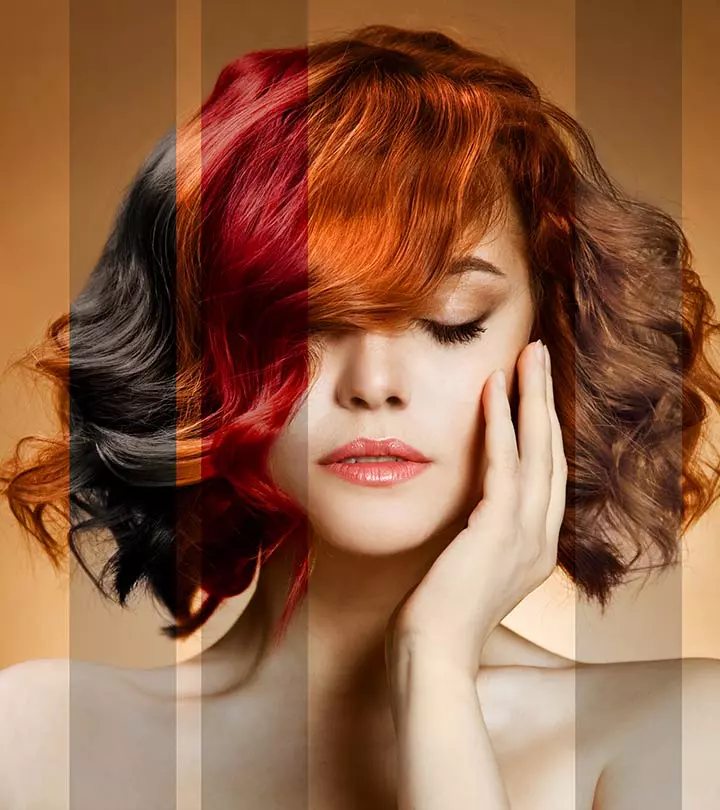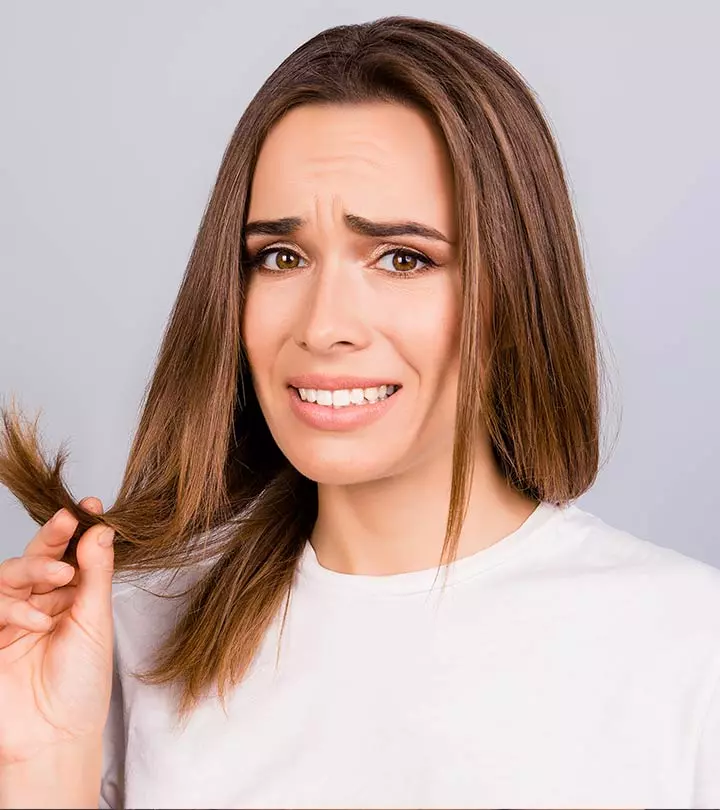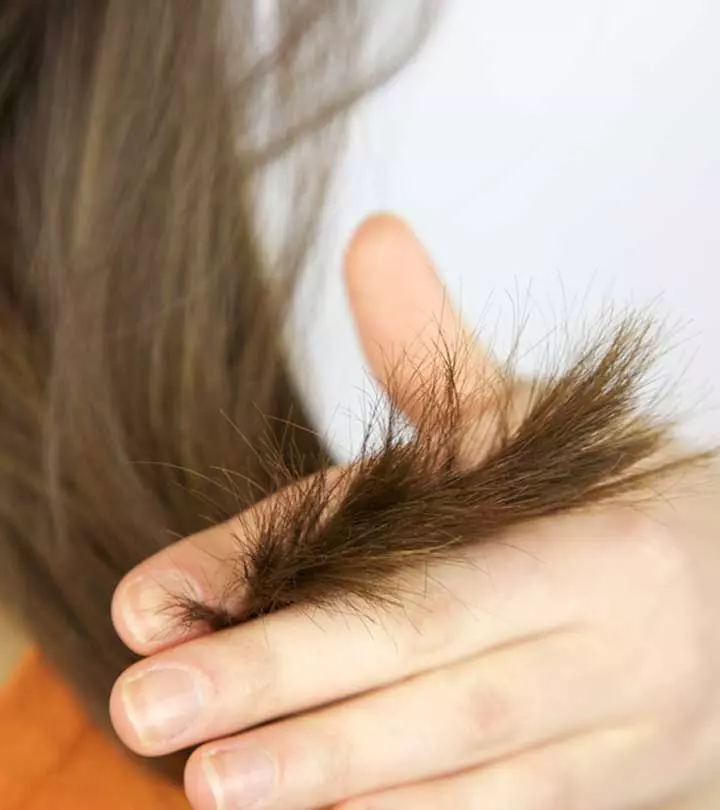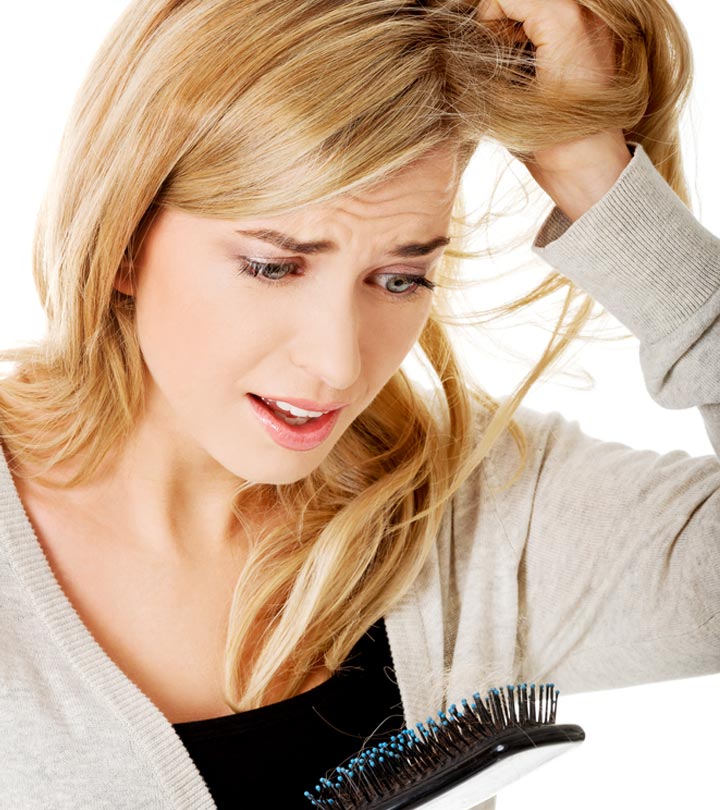Understanding The Different Types Of Split Ends
You can classify dry and brittle ends based on what led to breakage in the first place.

Image: ShutterStock
Split ends can damage your hair and affect its overall appearance. There are many types of split ends, and each is caused by different factors. The fast-paced life may not allow us to spend enough time on hair maintenance. We depend on instant solutions most of the time instead of addressing the root cause. And this severely damages the hair roots and scalp. Simple hair styling techniques like straightening, curling, excessive coloring, and even frequent brushing or combing may cause hair damage and split ends. Knowing the type of split ends you have will help you determine how to reduce hair breakage and damage and prevent them.
In this article, we will discuss what do split ends look like, their causes, and how you can handle them without compromising on your hair quality. Read further to know more.
In This Article
Different Types Of Split Ends – What They Mean And How To Treat Them

1. The Basic Split
Also known as traditional split ends, basic split ends are the most common type of splits.
These are caused when the cortical cells of the hair begin to separate from each other, although they are still largely held together. Basic split ends form due to dehydration, dryness, strain, and friction.
How To Fix
You need to nourish and hydrate your hair more often. The good news is, you can fix split ends without cutting your hair.
- Oiling your hair once a week with coconut or olive oil can help you get rid of these basic splits.
- You can also use honey-based DIY hair masks every week or every two weeks to hydrate your tresses naturally.
- Use a deep conditioner once every two weeks to provide intense moisture to your tresses.
- Replenish your diet with nuts rich in zinc, like pecans and walnuts, to avoid traditional split ends.
2. The Baby Or Mini Split
Baby splits are smaller in proportion to regular split ends and indicate early split-end development. If you catch a split end while it is still small, you need to treat it before it worsens.
How To Fix
Baby splits are a sign that your hair is dehydrated. Luckily, it can still be repaired if the necessary treatment is given on time. Use moisturizing hair masks and deep condition your hair to hydrate it. You also need to heal and seal those ends by going for regular trimming your hair.
3. The Triangle Or Fork Split
In this type of split ends, the hair end is divided into three strands, resembling a fork. Triangle or fork splits are a sign of widespread damage to the hair fiber.
How To Fix
You can prevent a fork split from progressing up to your hair strand by opting for professional deep conditioning hair treatments and trimming your hair regularly.
4. The Tree Split
In the tree split, several branches emerge from a single split end and the cortical cells begin to separate. This means one side of the hair shaft has been damaged more than the other. Sunburn and excessive weathering are some of the reasons behind tree split ends.
How To Fix
If you notice this type of split ends, you need to pay immediate attention to your hair and get a professional haircut. If not nourished properly, your hair can look intensely frizzy. Also, use a wide-toothed comb that does not snag at the split ends.
5. The Candle Split
The candle split is slightly different from the other types of splits in that it has not yet been converted into a split, but it can any time soon. Your hair looks much thinner at the ends, and the damage on the outer cuticle is pretty evident.
How To Fix
First, you need a trim to halt the candle split end from traveling up your hair shaft. You can then go for a nourishing oil massage or a split end treatment to nourish your hair back to good health.
6. The Single-Strand Knot

The single-strand knot normally occurs in curly hair when a curl is tangled and causes a knot in a single strand, initiating multiple tangles. This leads to breakage while brushing your hair.
How To Fix
To avoid single-strand knots, you should be very careful every time you brush your curls. You can use any natural oil or a detangling hair product and a wide-toothed comb to gently loosen and detangle the single-strand knot. Use a hair serum, a leave-in conditioner, and moisturizing hair masks regularly to make your locks smooth and resistant to single-strand knots.
7. The Feather Split
The feather split looks like a feather, with many splits along one side of the hair shaft. A feather split is a sign that your hair may be beyond repair since it is very difficult to fix. This type of split end can be caused by frequent chemical treatments, hair coloring, or irregular trimming.
How To Fix
If you have feather splits – do not panic. The important thing is to catch the split end before it results in any further damage. First, consult your hairstylist or book a professional hair treatment at a spa. You must also keep your hair tied in a bun as leaving it open can increase friction on the ends, causing your strands to split further.
8. The Crinkle Split
The crinkle split end occurs due to environmental pollutants or when the hair is frequently stretched to the breaking point. This can give a wrinkled look to your hair, making it look shabby and rough.
How To Fix
A good oil massage or a professional spa treatment can help you eliminate crinkled splits.
9. The Mid-Shaft Split
Also called the incomplete split, the mid-shaft split end is caused in the middle of the hair strand and closes towards the end. This simply means that the hair shaft is still in the process of splitting but has not been entirely damaged.
How To Fix
Mid-shaft splits can still be controlled. You can start working on a better hair care regimen to take good care of your locks. Be cautious while combing or brushing, and let your tresses breathe by moisturizing them regularly.
10. The Long Split
In the long split, the hair shaft starts to separate from a specific spot. This is generally caused by using too many hair accessories that split and weaken the hair at a specific spot.
How To Fix
Again, this type of split is at the initial stage, and you can work on it! With good replenishment of nutrients to the hair, a long split can be repaired or prevented.
11. The Deep Or Basic Y Split
The basic Y is a typical split end and the one we all dread the most. The cuticle peels at a precise spot due to damage from physical stressors or chemicals.
How To Fix
There is no cure for this, but precautions should be taken to avoid such deep splits. It is suggested to get an immediate trim and keep your hair hydrated and damage-free in the future.
12. The Taper Split
In this type of split end, the cuticle peels away and leaves the cortex visible. Your hair ends are thin and tapered, and you may even see a hole between the strands. The taper split is typically an outcome of chemical damage to the hair.
How To Fix
Frequent trims can stop taper splits from traveling up the hair shaft. Avoid using hair colors or harsh hair treatments to prevent this type of split ends.
13. The Thickened Split
In the thickened split, the hair texture thickens along the shaft, giving a rough and damaged look to the hair. Although the ends are intact, the quality of the texture is greatly reduced. This type of split ends mainly caused due to certain medications or hormonal imbalances.
How To Fix
Using a moisturizing shampoo and conditioner can make your hair look smoother and improve the hair texture. Apart from that, consider speaking to your healthcare provider to get tested for any hormonal issues that need to be treated.
14. The Whitened Split
The whitened split is when you notice white spots on your hair ends. These visible spots occur due to severe chemical treatments.
How To Fix
You must book an appointment for professional hair treatment as these types of split ends are clearly visible. Make changes in your diet and the way you look after your hair. Oiling and moisturizing are a must in this condition.
15. The Right-Angle Split
The right-angle split is the beginning of a split as the bend is visible, but the split is still underway. This is a bend that is caused by frequently tying the hair in a specific hairstyle.
How To Fix
You must change your hairstyle and keep your hair protected. A thorough hair care regimen to nourish your hair can avoid right angle split ends.
16. The Offshoot Split
Caused by pollutants or chemical heat, the offshoot split is a cross that occurs between a tangle and a bend. The hair strand thickens along the shaft and then bonds together again in this type of split.
How To Fix
Oiling, trimming, hair spas, and keeping your hair neatly tied can avoid such split ends. Take a quick look at the different types of split ends.

For healthy, split-free hair that is soft to the touch, you should be aware of the causes that contribute massively to hair damage and split ends. Let us study these factors in more detail below.
Factors That Cause Split Ends

- Pollution
Pollution, smoke, and other environmental pollutants are major contributors to damaged hair. They settle on your scalp and result in itchiness and dryness, thus causing different types of splits.
- Over-Washing
Over-washing removes the natural oils from the scalp and dries out your tresses. A mild shampoo will help a lot in shielding your hair from damage and split ends. Also, limit your hair washing to no more than twice a week. If more frequent washing is required due to your lifestyle, be sure to concentrate the shampoo only on the scalp. Avoid the ends of the hair strands.
- Weather
The constant change in temperature and cold winds can wreak havoc on your hair and cause severe loss in moisture, resulting in damaging split ends.
- Heat Styling
By cranking the temperature up on your hair and constantly exposing it to heat styling tools like flat irons and curling irons, you stand to make your locks rough, brittle, and weak over time.
- Chemical Treatments
Your hair bears the brunt of chemical stressors such as keratin treatments, bleach, and relaxers, resulting in lifeless and brittle tresses that become rough.
- Hard Water
Hard water
has higher levels of magnesium and calcium content, which leave a soap film on your hair and prevent it from absorbing moisture. This makes your hair look lifeless and causes different types of split ends.
Now, let’s check out some tips for minimizing and preventing different types of split ends.
How To Prevent Split Ends

- Style your hair in protective hairdos and avoid excessively tight hairstyles.
- Seal your hair ends with a hair serum or an oil-based product.
- Keep your hair tangle-free and use a deep conditioner to moisturize your hair after each wash.
- Always be gentle while combing and brushing your hair, and try detangling your hair using your fingers first. Avoid brushing the hair when wet, as it will cause the cuticles to stretch.
- Seek professional help when using chemicals like hair colors and relaxers.
- Get protein treatment and hair spas to prevent hair damage.
- Use heat protectant and ceramic heat styling tools when using heat on your hair.
- Get regular trims.
- Keep your hair hydrated and oil it regularly. Oiling can solve many common hair problems.
Junpei, a blogger, reflects on the impact of split ends on her hair: “These damn split ends were adamant on never going away regardless of the fact that I oiled my hair and washed it frequently.” She shares her frustration with split ends and how they led to drastic haircuts. However, an important realization also dawns on her. She writes, “I am a person too, and an able bodied one, with the pressure of full-on adulthood breathing down my neck. I have exams to study for, a job to land, and money to save. Hair right now is not such a big concern (i)”.
The idea that split ends can stop hair growth is a common saying. Let us uncover the truth behind it in the next section.
Can Split Ends Stop Hair Growth?
Split ends can make your hair appear less healthy and more prone to breakage; however, they do not directly stop your hair from growing. This is because hair growth occurs from the roots on your scalp, while split ends appear at the ends of the hair shaft. Then, why does it look like your hair is not growing when you have split ends? This mainly happens because the hair at the ends breaks faster due to split ends, and the new growth takes time to become noticeable, giving you the appearance of stagnant or slow hair growth.
Split ends are an annoyance that may hamper your hair’s look and healthy hair growth. They can be caused due to weather changes, over-washing, or overuse of heat styling tools. Different types of split ends suggest different degrees of hair damage. Baby splits indicate your hair is dehydrated and requires moisture, while tree splits are the result of your hair shaft being damaged. Following basic hair care methods along with a simple, quick trim can help treat and prevent split ends and frays in the future. Therefore, it is strongly advised that you keep track of your hair care routine and nourish your hair on a regular basis.
Frequently Asked Questions
Can shampoo fix split ends?
No. Shampoo can’t get rid of split ends. You must trim the split ends to eliminate them and use moisturizing products like deep conditioners, serums, and leave-in products to prevent split ends.
Can split ends get worse?
Yes. If you don’t trim away the split ends, they can keep progressing upwards on your hair strand, creating fissures, splints, and fractures before breaking off your hair.
Does cold water help split ends?
Cold water may help prevent split ends as it helps seal the hair cuticles and ends.
Are split ends the same as dead ends?
No. Dead ends have a rough, dry texture, while split ends still have the soft texture of your hair.
Do split ends look white?
Yes. Split ends may have white tips that indicate that the hair is fractured and damaged.
Key Takeaways
- Triangle or fork splits are a sign of widespread damage to the hair fiber.
- The whitened splits occur due to severe chemical treatments.
- Pollution, smoke, and other environmental pollutants can lead to splits.
Illustration: Different Types Of Split Ends – How To Identify And Treat Them

Image: Dall·E/StyleCraze Design Team
Split ends may be really inconvenient! In this video, you’ll learn how to identify and cut them. Watch this video to learn how to get rid of those bothersome split ends and keep your hair looking healthy and beautiful.
Personal Experience: Source
StyleCraze's articles are interwoven with authentic personal narratives that provide depth and resonance to our content. Below are the sources of the personal accounts referenced in this article.
i.How Having Split Ends Led To An Epiphany.https://medium.com/@jun_jun_junpei/how-having-split-ends-led-to-an-epiphany-3ee8e6c1e8a5
Read full bio of Tiffany Young
Read full bio of Ramona Sinha
Read full bio of Medha Deb

























Community Experiences
Join the conversation and become a part of our empowering community! Share your stories, experiences, and insights to connect with other beauty, lifestyle, and health enthusiasts.